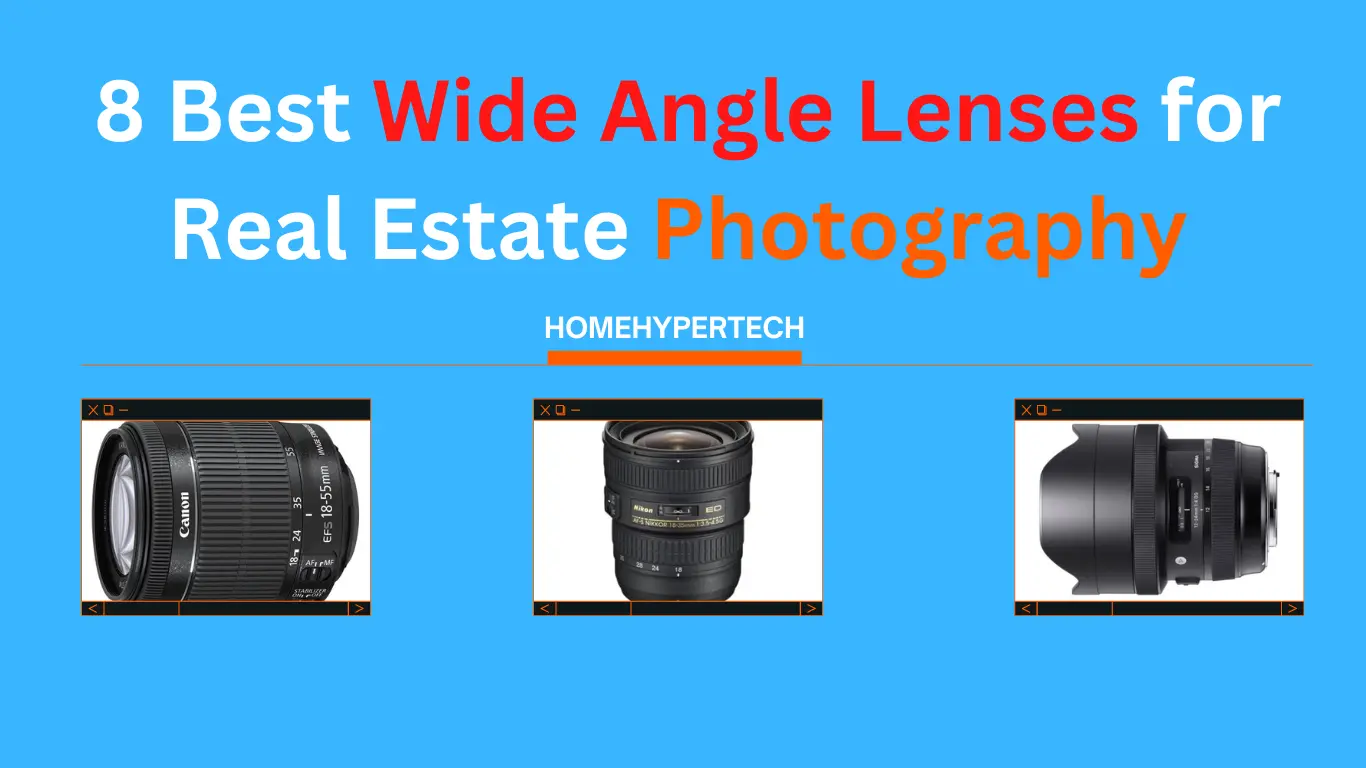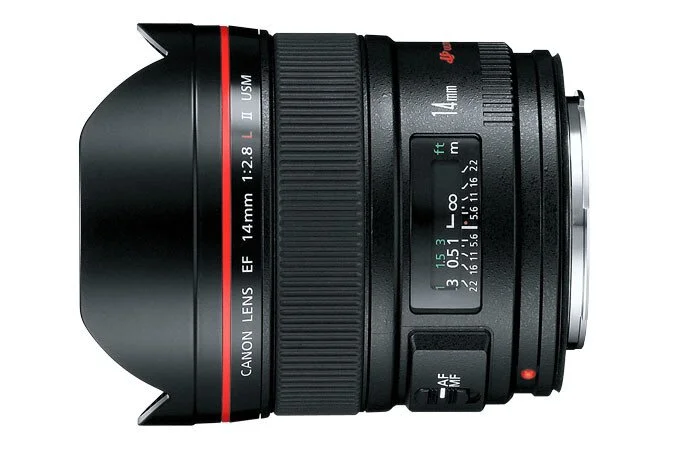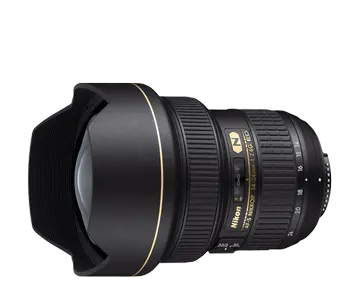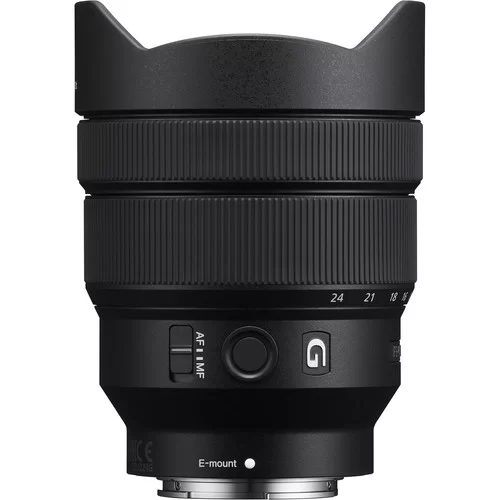8 Best Wide Angle Lenses for Real Estate Photography in 2024

Finding the best wide-angle lenses for real estate photography is a difficult task. Here, I will present the best collections of lenses. A popular choice for real estate photography is a wide-angle lens with a focal length of around 14–24 mm.
This type of lens allows you to capture a wide field of view, which is ideal for showing off the interior of a property, as well as its overall layout. Additionally, wide-angle lenses are known for their ability to minimize distortion, which is important for creating accurate representations of space.
Some popular models include the Canon EF 14mm f/2.8L II USM, the Nikon 14-24mm f/2.8G ED, and the Sony FE 12-24mm f/4 G.
However, another important note for real estate photography is that the lens should be shift-able, this will give you the ability to adjust perspective and keep lines looking straight, allowing you to take more precise and professional-looking photographs.
Also, the aperture should be large enough, f/2.8 is a common aperture and recommended, this will allow you to work in low light situations and create a shallow depth of field.
Surveyed the best wide-angle lenses for real estate photography
Because of the nature of the work, you will be required to use a wide-angle lens for real estate photography. Some popular wide-angle lenses for real estate photography include,
- Canon EF 16-35mm f/4L IS USM
- the Nikon 14-24mm f/2.8G ED
- Sony FE 12-24mm f/4 G
These lenses are known for their sharpness, low distortion, and ability to capture a wide field of view. These wide-angle lenses are well-suited for real estate photography.
Top 3 Lens (Best Wide Angle Lenses for Real Estate Photography)
Canon EF 14mm f/2.8L II USM
The Canon EF 14mm f/2.8L II USM is a professional-grade ultra-wide angle lens designed for use with full-frame Canon EOS cameras. It has a fixed focal length of 14mm which gives it a wide field of view, making it well-suited for real estate photography and other types of wide-angle shots.

One of its key features is its f/2.8 maximum aperture, which allows for a shallow depth of field, which is a desirable effect for this type of photography and for working in low light conditions. The aperture also makes it possible to produce stunning images with stunning bokeh.
The lens also features a fast and silent Ultrasonic Motor (USM) for quick and accurate autofocus, and manual focus overrides at any time. It also has a circular aperture diaphragm to help produce beautiful out-of-focus areas (bokeh) and improved image quality.
Additionally, it has a solid build quality and weather-sealing that makes it durable and able to handle challenging conditions, which makes it a great option for outdoor and indoor photography.
Overall, the Canon EF 14mm f/2.8L II USM is a high-quality, versatile, and well-built lens that is well-suited for real estate photography and other wide-angle applications.
Nikon 14-24mm f/2.8G ED
The Nikon 14–24mm f/2.8G ED is a professional-grade ultra-wide-angle zoom lens designed for use with full-frame Nikon DSLR cameras. It has a focal length range of 14–24mm, which provides a wide field of view, making it well-suited for real estate photography, architectural photography, as well as landscape, and astrophotography.

One of the key features of this lens is its fast constant f/2.8 maximum aperture, which is well-suited for low-light situations and allows you to create a shallow depth of field, which is a desirable effect for this type of photography.
The lens also features Nikon’s ED (Extra-low Dispersion) glass element which helps to produce sharper images and minimize chromatic aberration. Additionally, it uses Nikon’s Nano Crystal Coat and Super Integrated Coating to reduce flare and ghosting.
The lens is also built to a high standard with durable, weather-sealed construction, which makes it suitable for working in challenging conditions. It also has a silent wave motor (SWM) that provides smooth and fast autofocus, and it has a manual override option at any time.
In summary, the Nikon 14–24mm f/2.8G ED is a high-quality, versatile, and well-built lens that is well-suited for real estate photography, architectural photography, and other wide-angle applications.
Sony FE 12-24mm f/4 G
The Sony FE 12–24mm f/4 G is a professional-grade ultra-wide-angle zoom lens designed for use with Sony’s full-frame E-mount mirrorless cameras. It has a focal length range of 12–24mm, which provides a wide field of view and makes it well-suited for real estate photography, architectural photography, as well as landscape and astrophotography.

One of the key features of this lens is its constant f/4 maximum aperture, which is suitable for low-light situations and allows you to create a shallow depth of field. Although it’s not as fast as some other options with an f/2.8 aperture, it can still produce good results.
The lens has a good build quality with a dust and moisture-resistant design that makes it suitable for working in challenging conditions. It also features Sony’s advanced optics, including aspherical and ED (Extra-low Dispersion) glass elements which help to produce sharp images and minimize chromatic aberration.
The lens is also equipped with Sony’s Direct Drive Super Sonic Wave Motor (DDSSM), which provides fast, accurate, and silent autofocus. It also has a manual focus option that allows you to fine-tune focus even when using AF.
In summary, the Sony FE 12–24mm f/4 G is a high-quality, versatile, and well-built lens that is well-suited for real estate photography, architectural photography, and other wide-angle applications. Although it’s a bit slower, it can still produce good results.
8 Best wide-angle Lenses for real estate photography
1. CANON 17-40MM F4
Description
The Canon 17-40mm f/4 lens is a standard zoom lens designed for use with full-frame Canon EOS cameras. It has a focal length range of 17-40mm, which provides a moderate wide-angle to short telephoto range, making it suitable for a wide variety of photography applications, including landscapes, cityscapes, architecture, interiors, and portraits.
The lens has a maximum aperture of f/4, which is not as fast as some other lenses but is still suitable for low-light situations and allows you to create a shallow depth of field. It also features Canon’s Ultrasonic Motor (USM), which provides fast, quiet, and accurate autofocus and full-time manual focus override.
One of the key features of this lens is its circular aperture diaphragm which produces a pleasing bokeh. Additionally, it features one Super-UD glass element and one aspherical element which reduce chromatic aberration and produce sharp and clear images.
The lens has a durable and weather-resistant construction, making it suitable for working in challenging conditions. It also has a 77mm filter thread for attaching filters.
In terms of physical characteristics, The Canon 17-40mm f/4 lens is relatively compact and lightweight, measuring approximately 3.3 inches in length and weighing approximately 1 pound, which makes it easy to carry and handle.
Overall, The Canon 17-40mm f/4 lens is a versatile, durable, and high-quality lens that offers a great balance of image quality, focal range, and portability. It’s great for landscape, cityscape, and travel photography.
Pros
- Ultra-wide view
- Reasonable price
- Sharpness
Cons
- Some distortion
- Color fringing
2. Sigma 18-35mm f/1.8 Art lens
Description
The Sigma 18-35mm f/1.8 Art is a professional-grade zoom lens designed for use with full-frame cameras, although it is also compatible with APS-C-sized sensors, the equivalent focal length would be 27–52.5mm. It has a focal length range of 18–35mm, which provides a wide field of view and makes it well-suited for a variety of photography applications, including landscape, portrait, and street photography.
One of the key features of this lens is its fast, constant f/1.8 maximum aperture, which is well-suited for low-light situations and allows you to create a shallow depth of field. This aperture value also allows for a creamy bokeh and isolates the subject even more.
The lens features Sigma’s Global Vision line of lenses, which is characterized by exceptional image quality and build quality. The lens construction is composed of 17 elements in 12 groups, including two FLD (“F” Low Dispersion) glass elements and five SLD (Special Low Dispersion”) glass elements, which help to produce sharp images and minimize chromatic aberration.
Additionally, it has a Hyper Sonic Motor (HSM) that provides fast and quiet autofocus, and it also has a manual override option. The lens has a sturdy metal construction and is weather-sealed, so it can withstand challenging conditions.
In summary, the Sigma 18-35mm f/1.8 Art is a high-quality, versatile, and well-built lens that is well-suited for a variety of photography applications and will make it an ideal lens for both professionals and enthusiasts with its fast aperture value, high build quality, and image quality.
Pros
- Superior picture quality free-form
- Negligible vegetating
- Stunning lens construction and design.
Cons
- Massive (about the proportions of a full-frame 24-70mm f/2.8 lens).
- Not a cheap crop sensor.
3. Canon 16-35mm F/4
Description
The Canon EF 16-35mm f/4L IS USM is a professional-grade ultra-wide-angle zoom lens. This lens is designed for use with full-frame Canon EOS cameras. Its focal length range of 16–35 mm provides a wide field of view. This FL makes it well-suited for real estate photography and architectural photography. It can be used for landscape and astrophotography.
One of the key features of this lens is its fast constant f/4 maximum aperture. It’s not as fast as some other options with an f/2.8 aperture, but it still can produce good results, especially in well-lit environments. Additionally, it features image stabilization (IS) which helps to reduce camera shake and blur, making it a good option for handheld shooting.
The lens also features Canon’s L-series construction, which is known for its,
- High build quality
- weather-sealing
- Durable working in challenging conditions
- Fast and silent Ultrasonic Motor (USM) for quick and accurate autofocus
- Manual focus overrides at any time
It uses aspherical and UD (Ultra-low Dispersion) glass elements that help to produce sharp images and minimize chromatic aberration. Also, it has a circular aperture diaphragm to help produce beautiful out-of-focus areas (bokeh) and improved image quality.
In summary, the Canon EF 16-35mm f/4L IS USM is a high-quality, versatile, and well-built lens. This is well-suited for real estate photography, architectural photography, and other wide-angle applications.
Pros
- Lack of chromatic aberration.
- Fluorine coatings aid in maintaining a spotless exterior.
- Weather sealing
- The lens hood is well-designed and quite useful, especially in comparison to older WA zoom lenses.
Cons
- The maximum f/4 aperture may be too narrow for certain users.
- It is possible to hear the AF and IS while they are working.
4. Sigma 14-24mm F/2.8 DG HSM
Description
The Sigma 14–24mm F/2.8 DG HSM is a wide-angle zoom lens for full-frame cameras. It has a constant maximum aperture of f/2.8 throughout the zoom range, which allows for consistent low-light performance and a shallow depth of field. The lens also features a Hyper Sonic Motor (HSM) for fast, quiet autofocus, as well as a DG designation, indicating that it is optimized for use with digital cameras. Additionally, it has three FLD glass elements and one SLD glass element. This helps to reduce chromatic aberrations and provide sharper images.
It is designed for professional use and has been built to withstand the rigors of professional use, with a dust- and splash-proof construction. A special coating on the front element helps to repel water and fingerprints. It is a heavy lens, but it has a zoom ring that is smooth and easy to use.
Pro
- Unparalleled accuracy.
- Extremely broad perspective.
- Exposure brightness.
- Can withstand airborne dust and liquids.
- Accessible on a number of platforms.
Cons
- Cannot use pre-filters at the front.
- Only Canon’s version has a rear filter holder.
5. Rokinon AF 14mm f/2.8 Lens
Description
The Rokinon AF 14mm f/2.8 Lens is a wide-angle lens that is designed for full-frame cameras. It features a fast f/2.8 aperture that allows for low-light photography and shallow depth-of-field effects. This lens has a wide angle of view of 114.6 degrees, making it ideal for landscape, architecture, and astrophotography.
The lens is constructed with 14 elements in 12 groups, including 3 aspherical elements and 1 high refractive index element, which helps to minimize distortion and improve image sharpness. It also has a 9-blade aperture for smooth bokeh effects.
The Rokinon AF 14mm f/2.8 Lens also features a fast and accurate autofocus system, making it easy to capture sharp images even in challenging conditions. It is also weather-sealed, making it a durable and reliable option for outdoor photography.
Overall, the Rokinon AF 14mm f/2.8 Lens is a high-quality wide-angle lens that offers a fast aperture, sharp image quality, and weather-sealed construction. It is a great choice for photographers looking to capture stunning landscape and architectural images with a wide angle of view.
Pros
- Extremely low chromatic aberrations
- Extremely resistant to igniting
- Superb accuracy in displaying colors
- Very good micro contrast
- Great for nighttime landscapes because of its minimal coma.
- Excellent durability in construction
Cons
- There is no usage of regular filters.
- Vignetting that is somewhat heavy
- Cap for the lens is awkward to carry about.
- The lens’ distance scale is inconsistent.
6. Nikon 10-20mm f/4.5-5.6
Description
Nikon’s wide angle lens for real estate photography on DX bodies is 10-20mm f/4.5–5.6. It is a 14-30mm lens in full frame terms, covering a broad to the extremely wide angle of view. The compactness and portability of this lens are immediately apparent. You won’t have to worry about it adding extra bulk to your gear since it just weighs 8 ounces (230 grams). It’s compact and takes up little room, measuring only 3 inches (77mm). Overall, the design seems and maybe even feels a touch cheap due to the extensive usage of polycarbonate, but this is a cheap lens.
Pros
- Slim and portable.
- Includes a vast field of vision.
- Very perceptive.
- Retaining optical constancy.
- Inexpensive.
Cons
- Ten millimeters of rounded-off sharpness.
- The barrel distortion is really obvious.
- There’s a gloomy air in the shadows.
- There is a discord in the colors.
7. Samyang 14mm F2.8
Description
With the RF14 and its 14mm focal length, you may capture strikingly dynamic photos. Very wide focal lengths have a tendency to make everything appear to have been pushed out from the camera, causing foreground items to stand out in a dramatic fashion, making it a tough lens to compose with if you aren’t used to utilizing wide-angle lenses.
Pros
- A telephoto lens with a very wide field of view
- Ring That Gently Adjusts Aperture And Focus
- The modality for locking focus
- Clickable aperture
- Top-notch construction
- Protected from the elements, it may be used in bad weather.
- Incredibly acute when slowed down
Cons
- The Distortion of the Barrel and Its Radius (Moustache Distortion)
- Wide-open shooting causes coma and astigmatism.
8. Sony E 10-18mm F4
Description
The Sony E 10-18mm F4 lens is a wide-angle zoom lens designed for use with Sony E-mount cameras. It has a focal length range of 10-18mm, which allows for a wide field of view and makes it ideal for capturing landscapes, architecture, and group shots. The lens has a constant maximum aperture of F4, which allows for consistent exposure and depth of field throughout the zoom range. It also features an advanced optical design with aspherical and ED elements, which helps to reduce chromatic aberrations and produce sharp and detailed images. The lens also has a compact and lightweight design, making it easy to carry around and use for everyday photography.
Pros
- Superior visuals.
- Retaining optical constancy.
- Slim and portable.
- Accepts filters at the front.
- Viewing capability with a very large field of vision.
Cons
- There’s a slant to the distortion.
- Lacks protection against dust and liquids.
Conclusion (Best Wide Angle Lenses for Real Estate Photography)
A wide-angle lens is a great choice for real estate photography as it allows for capturing large, detailed spaces and showing the layout of a property. The Sony E 10-18mm F4 lens, in particular, offers a versatile focal length range, consistent aperture, and advanced optical design that make it suitable for capturing high-quality images of real estate properties. Additionally, its compact and lightweight design makes it easy to maneuver around a property, allowing you to capture a variety of angles and perspectives. Overall, a wide-angle lens like the Sony E 10-18mm F4 can help to showcase a property in the best light and give potential buyers a comprehensive view of the space.

I am a content writer and affiliate marketer with a passion for crafting engaging and informative content that drives traffic and sales. With years of experience in the industry, I have honed my skills in SEO, social media marketing, and email marketing to help businesses reach their target audience and achieve their goals.
